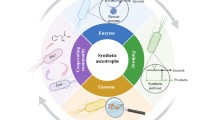Abstract
Increasing recombinant protein production yields from bacterial cultures remains an important challenge in biotechnology. Acetate accumulation due to high dissolved carbon dioxide (pCO2) concentrations in the medium has been identified as a factor that negatively affects such yields. Under appropriate culture conditions, acetate could be re-assimilated by bacterial cells to maintain heterologous proteins production. In this work, we developed a simplified metabolic network aiming to establish a reaction rate analysis for a recombinant Escherichia coli when producing green fluorescent protein (GFP) under controlled pCO2 concentrations. Because E. coli is able to consume both glucose and acetate, the analysis was performed in two stages. Our results indicated that GFP synthesis is an independent process of cellular growth in some culture phases. Additionally, recombinant protein production is influenced by the available carbon source and the amount of pCO2 in the culture medium. When growing on glucose, the increase in the pCO2 concentration produced a down-regulation of central carbon metabolism by directing the carbon flux toward acetate accumulation; as a result, cellular growth and the overall GFP yield decreased. However, the maximum specific rate of GFP synthesis occurred with acetate as the main available carbon source, despite the low activity in the other metabolic pathways. To maintain cellular functions, including GFP synthesis, carbon flux was re-distributed toward the tricarboxylic acid cycle and the pentose phosphate pathway to produce ATP and NADH. The thermodynamic analysis allowed demonstrating the feasibility of the simplified network for describing the metabolic state of a recombinant system.
Similar content being viewed by others
References
Lee, S., H. Kim, J. Park, J. Park, and T. Kim (2009) Metabolic engineering of microorganisms: General strategies and drug production. Drug. Discov. Today 14: 78–88.
Stephanopoulos, G. and J. Vallino (1991) Network rigidity and metabolic engineering in metabolite overproduction. Sci. 252: 1675–1681.
Swartz, J. R. (2001) Advances in Escherichia coli production of therapeutic proteins. Curr. Opin. Biotechnol. 12: 195–201.
Carneiro, S., S. Villas-Bôas, I. Rocha, and E. Ferreira (2010) Applying a metabolic foot printing approach to characterize the impact of the recombinant protein production in Escherichia coli. pp. 193–200. In: M. P. Rocha (eds.). Advances in Bioinformatics. Springer Berlin Heidelberg.
Dixon, N. M. and D. Kell (1989) The inhibition by CO2 of the growth and metabolism of micro-organisms. J. Appl. Bacteriol. 67: 109–136.
Bäumchen, C., A. Knoll, B. Husemann, J. Seletzky, B. Maier, C. Dietrich, G. Amoabediny, and J. Büchs (2007) Effect of dissolved carbon dioxide concentrations on growth of Corynebacterium glutamicum on D-glucose and L-lactate. J. Biotechnol. 128: 868–874.
Oh, M. K. and J. Liao (2000) DNA microarray detection of metabolic responses to protein overproduction in Escherichia coli. Metabol. Eng. 2: 201–209.
Richins, R. and W. Chen (2001) Effects of FIS over expression on cell growth, rRNA synthesis, and ribosome content in Escherichia coli. Biotechnol. Prog. 17: 252–257.
Causey, T., K. Shanmugam, L. Yomano, and L. Ingram (2004) Engineering Escherichia coli for efficient conversion of glucose to pyruvate. Proc. Natl. Acad. Sci. USA. 101: 2235–2240.
Kim, Y., L. Ingram, and K. Shanmugan (2007) Construction of an Escherichia coli K-17 mutant for homoethanologenic fermentation of glucose of xylose without foreign genes. Appl. Environ. Microbiol. 73: 1766–1771.
Atsumi, S., A. Cann, M. Connor, C. Shen, K. Smith, M. Brynildsen, M. Chou, T. Hanai, and J. Liao (2008) Metabolic engineering of E. coli for 1-butanol production. Metabol. Eng. 10: 305–311.
Henry, C., M. Jankowski, L. Broadbelt, and V. Hatzimanikatis (2006) Genome-scale thermodynamic analysis of Escherichia coli metabolism. Biophysic. J. 90: 1453–1461.
Henry, C., L. Broadbelt, and V. Hatzimanikatis (2007) Thermodynamics-based metabolic flux analysis. Biophysic. J. 92: 1792–1805.
Mavrovouniotis, M. L., G. Stephanopoulos, and G. Stephanopoulos (1990) Computer-aided synthesis of biochemical pathways. Biotechnol. Bioeng. 36: 1119–1132.
Liu, L., R. Agren, S. Bordel, and J. Nielsen (2010) Use of genome-scale metabolic models for understanding microbial physiology. FEBS Lett. 584: 2556–2564.
Stephanopoulos, G., A. Aristos, and J. Nielsen (1998) Metabolic engineering: principles and methodologies. pp. 285–307; 326–330. Academic Press, USA.
Garg, S., L. Yang, and R. Mahadevan (2010) Thermodynamic analysis of regulation on metabolic networks using constrained-based modeling. BMC Res. Notes. 3: 125.
Mavrovouniotis, M. L. (1990) Group contributions for estimating standard Gibbs energies of formation of biochemical compounds in aqueous solution. Biotechnol. Bioeng. 36: 1070–1082.
Mavrovouniotis, M. L. (1991) Estimation of standard Gibbs energy changes of biotransformations. J. Biol. Chem. 266: 14440–14445.
Albe, K. R., M. Butler, and B. Wright (1990) Cellular concentrations of enzymes and their substrates. J. Theor. Biol. 143: 163–195.
Baez, A., N. Flores, F. Bolivar, and O. Ramírez (2009) Metabolic and transcriptional response of recombinant Escherichia coli to elevated dissolved carbon dioxide concentrations. Biotechnol. Bioeng. 104: 102–110.
Bearson, B. L., I. S. Lee, and T. A. Casey (2009) Escherichia coli O157: H7 glutamate- and arginine-dependent acid-resistance systems protect against oxidative stress during extreme acid challenge. Microbiol. 155: 805–812.
Nielsen, J. (2001) Metabolic engineering. Appl. Microbiol. Biot. 55: 263–283.
Vallino, J. J. (1991) Identification of branch-point restrictions in microbial metabolism through metabolic flux analysis and local network perturbations. Ph.D. Thesis. Massachusetts Institute of Technology, Cambridge, MA, USA.
Nielsen, J., J. Villadsen, and G. Liden (1994) Bioreaction Engineering Principles. 1st ed., pp. 24–27. Plenum Press, NY, USA.
Shojaosadati, S. A., S. Varedi-Kolaei, V. Babaeipur, and A. M. Farnoud (2008) Recent advances in high cell density cultivation for production of recombinant protein. Iran J. Biotechnol. 6: 63–84.
Author information
Authors and Affiliations
Corresponding author
Rights and permissions
About this article
Cite this article
González-García, R.A., Garcia-Peña, E.I., Salgado-Manjarrez, E. et al. Metabolic flux distribution and thermodynamic analysis of green fluorescent protein production in recombinant Escherichia coli: The effect of carbon source and CO 2 partial pressure. Biotechnol Bioproc E 18, 1049–1061 (2013). https://doi.org/10.1007/s12257-013-0277-5
Received:
Revised:
Accepted:
Published:
Issue Date:
DOI: https://doi.org/10.1007/s12257-013-0277-5




